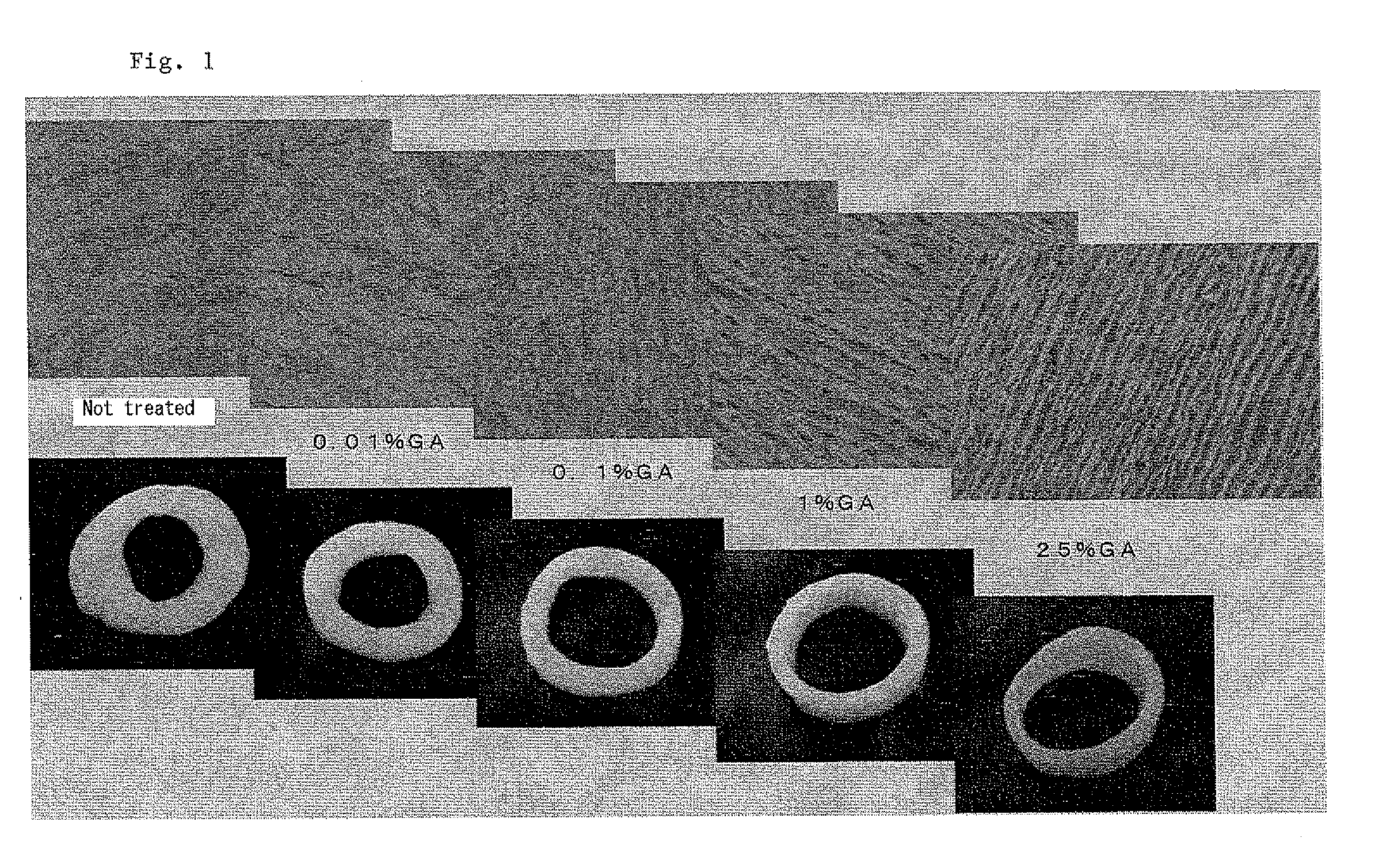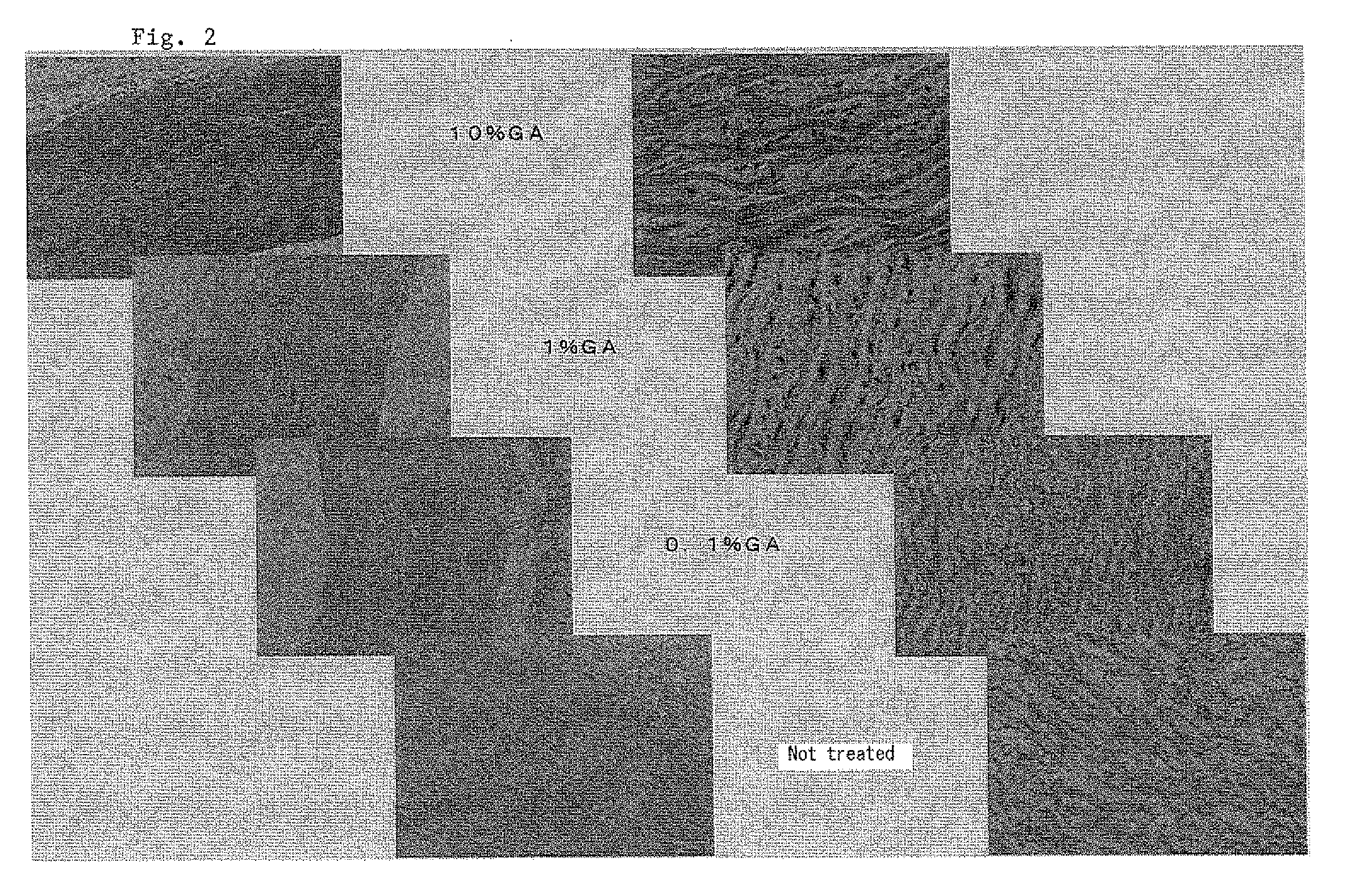Method for preparing biological scaffold material
a biological scaffold and material technology, applied in the field of regenerative medical technology, can solve the problems of limited durability, restenosis and other adverse effects, and the inability to use biodegradable vascular grafts in the arterial system,
- Summary
- Abstract
- Description
- Claims
- Application Information
AI Technical Summary
Problems solved by technology
Method used
Image
Examples
example 1
[0020]Porcine aorta tissue segments were treated with 0.01% GA, 0.1% GA, 1% GA and 25% GA, respectively, at room temperature for 1 hour, and then subjected to enzymatic degradation of elastin under the above constant condition. As a control, a tissue segment not treated with GA was also subjected to the enzymatic degradiation of elastin under the same conditions. FIG. 1 shows in the photographs in the lower row appearance of annularly cut aorta segments and histographic pictures of the tissue segment stained with hemotoxilin-eosin in the upper row. As shown in FIG. 1, untreated tissue and treated tissue with 0.01% GA were excessively loosened by the enzymatic removal of elastin and did not retain the original shape. In contrast, the tissues treated with 1% GA and 25% GA, respectively, were observed to contain an amount of elastin sufficient to retain the original shape after the treatment with the enzyme due to partial cross-linking with GA. Essentially complete removal of elastin w...
example 2
[0021]As in Example 1, porcine aorta tissue segments were treated with GA at varying concentrations from 0% to 25%, and then subjected to enzymatic degradation of elastin. Cytographic pictures were taken after staining hemotoxylin-eosin at different enlargement scales. As shown in FIG. 2, excessive loosening of the tissue was observed in the tissue not treated with GA. In the tissue treated with 1% GA or 10% GA, many elastin fibers and cell nuclei were observed.
example 3
[0022]Porcine aorta tissue segments were treated with GA and elastase under the same conditions as in Example 2, and the stained by the Elastica von Gieson method, FIG. 3 shows enlarged histographic pictures of tissues thus treated. According to the above staining method, collagen fibers appear significantly darker than elastin fibers in monochromatic photographs. As observed from the pictures, residual elastin fibers increased with increase in GA concentration.
[0023]The tissue segment treated with 0.1% GA in Example 2 was digested with collagenase (228 U / mg, Wako Pure Chemical) in tris-buffer and the digested solution was analyzed spectroscopically. An absorption near 280 nm responsible for aromatic amino acids was observed indicating the biodegradability of the scaffold produced by the method according to the present invention.
[0024]As a result of the foregoing experiments, the effect of the treatment of a native tissue with glutaraldehyde under appropriate conditions before remov...
PUM
| Property | Measurement | Unit |
|---|---|---|
| pH | aaaaa | aaaaa |
| incubation time | aaaaa | aaaaa |
| incubation time | aaaaa | aaaaa |
Abstract
Description
Claims
Application Information
 Login to View More
Login to View More - R&D
- Intellectual Property
- Life Sciences
- Materials
- Tech Scout
- Unparalleled Data Quality
- Higher Quality Content
- 60% Fewer Hallucinations
Browse by: Latest US Patents, China's latest patents, Technical Efficacy Thesaurus, Application Domain, Technology Topic, Popular Technical Reports.
© 2025 PatSnap. All rights reserved.Legal|Privacy policy|Modern Slavery Act Transparency Statement|Sitemap|About US| Contact US: help@patsnap.com



